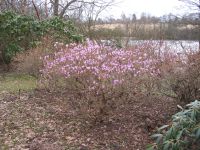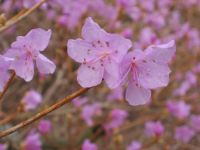Korean rhododendron - Rhododendron mucronulatum
English name:
Korean rhododendron
Scientific name:
Rhododendron mucronulatum
Family:
Ericaceae (heath family)
Height:
0.5 to 2 M dependent on provenance
Flowering:
before leaf unfolding March to April
Range:
Northern China, Korea, bordering areas in Russia, Japan
 |
 |
The 27 year old Rhododendron mucronulatumin the pictures is from seed collected in the wild on Mt. Seolak-san in South Korea. It can be found by the trail nearest to the lake in our Alnus and Betula woodland; square 1207 position 3723.
Plant description:
Rhododendron is one of the largest woody-plant genera in the world. It comprises about 800 different wild species. (Experts disagree on the exact number.) This remarkable genus is renowned for its beautiful flowers, striking foliage and in some cases attractive bark. Rhododendron species can be found within 15 degrees of the North Pole in Greenland, and as far south as the jungles of northeast Australia. Some species are 30 m tall trees, others are ground hugging dwarfs and some are even epiphytes, living on the branches of other trees. They can be evergreen or deciduous. Rhododendrons hybridise easily with each other and many valuable garden plants have been developed within this genus as a result. They contribute significantly to the economy of the nursery trade. The Arboretum in Hørsholm has about 150 species of Rhododendron in its collection. Many are still rather young, so the display of flowers and foliage can be expected to develop considerably in the upcoming years.
Along with the closely related R. dauricum, R. mucronulatum marks the beginning of the Rhododendron flowering season in Hørsholm. We have 106 examples of Rhododendron mucronulatum in Hørsholm. Our oldest living plants come from the Nordic Arboretum Councils expedition to South Korea in 1976. We have 8 different provenances of R. mucronulatum from this expedition. They differ in size and when they flower. Some plants will be in flower throughout most, if not all, of April. The most compact plants come from Mt. Halle on Cheju Island and are late flowering. The second most compact, and first in flower (third week in March this year) come from seed collected at 1700 M elevation on Mount Seolak-San, in northeast South Korea.
Rhododendron mucronulatum was first described in 1837 and first introduced into Denmark between 1912 and 1920. A substantial number of named clones of this species are known to the nursery trade.
These are deciduous shrubs, often with rather twisting-rambling branches. Autumn leaf colour is often very good in R. mucronulatum. The scales on their leaves and twigs (that can be seen with a good magnifying lens), reveal that they belong to the subgenus Rhododendron (or lepidopes). In comparison to their nearest relative, the semi-evergreen R. dauricum, the leaf-scales are not so dense (2 4 times their diameter apart) and the flowers are larger in this species. However, there is considerable variation in these characters within these two species, and they hybridize to form swarms of intermediate types in nature. The widely, funnel-shaped, flowers are typically rosy-purple in colour, but can be pink and even white. They open successively from clusters of buds at the end of the shoots before the leaves expand. While they can be killed by frosts below -5C, damaged flowers are soon replaced by the next ones to open. We place our plants where they are not too exposed to the night sky in order to protect the flowers from spring frosts.
References:
Bean, W.J. 1976 Trees and Shrubs Hardy in the British Isles Vol III. N-Rh. Bean and Murray publishers. 973 pp.
Cox, P.A. & Cox, K.N.E. 1997. The Encyclopedia of Rhododendron species. Glendoic Publishing, Perth Scotland. 396 pp.
Davidian, H.H. 1982. The Rhododendron Species Vol I. Lepidotes. B.T. Batsford Ltd. London 431 pp.
Lange, J. 1994. Kulturplanternes Indførselshistorie i Danmark. (Introduction History of Cultivated Plants in Denmark). Jordbrugsforlaget, Frederiksberg. 458 pp.
Rhododendronforeningen: www.rhododendron.dk
